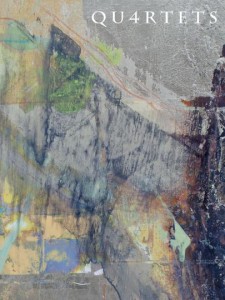Four Quartets by T.S. Eliot
I was reading (and absorbing) the beautiful catalog for “QU4RTETS, ” the exhibition by two painters and a musician organized by the International Arts Movement/Fujimura Institute to celebrate and explore Four Quartets, the poems written by T.S. Eliot. The catalog includes all of the works in the exhibition, the three artists’ statements, and three essays on each of the artists’ works.
I read a poetic line quoted in one of the essays, and I went scurrying to the bookshelf holding most of my poetry books. I found what I was looking for.
When I was in high school, I haunted a bookstore at Lakeside Shopping Center in suburban New Orleans, the first mall in the metropolitan area. The bookstore was called Dolphin Books, a small shop that specialized in the classics (I can’t imagine a store like this existing today, where you could walk in the door and breathe literature). It was where I bought an unabridged copy of Don Quixote by Cervantes for my senior English literature class. It was also where I bought a copy of Four Quartets, a slim little paperback that set me back all of 95 cents.
T.S. Eliot wrote the four poems over six years, with the last three poems written during the London Blitz. The four were not published together until Harcourt, Brace & World, Inc., published the first U.S. edition in 1943. This is the version I found on my bookshelf, although my little paperback would have been published more than two decades later (there’s no printing date in my edition, only the original publication date).

I hadn’t looked at the paperback in years. I pored over it, finding underlined words and lines, notes and questions written in the margins. And so I found I was facing a mystery of my own making: for what purpose had I done what looks to be such a close reading of Four Quartets?
Nothing comes to mind. I can’t recall a paper or assignment. I took the book with me to college. I took English literature, but we used the Norton’s Anthology exclusively, and no outside readings. I can recall the teacher running out of time before we reached the 20th century, and we barely touched the World War I poets before the semester ended (we spent two months on the Romantics – her field of specialization).
I reread the poems to see if it would jog my memory. All of my underlinings and margin notes are in the same blue pen, so I must have done the reading in one or two sittings. My memory wasn’t jogged, but I rediscovered the poems all over again. What T.S. Eliot did is impressive. And what I did not understand 40 years ago is how much these poems are about faith in a fragmented world.
The exhibition catalog, as I said, is beautiful. The paintings by Bruce Herman and Makoto Fujimura reproduced within it are stunning; the cover photo above is a detail from one of of the Herman paintings. Together with the music composed by Christopher Theofanidis, the works not so much interpret the Eliot poems as they explain some of the impact the poems have had on the artists.
The exhibition is currently at Baylor University, and will travel to Duke University, Yale, and Gordon College, and then to Japan, China and the United Kingdom.
I’m still wondering why I did that close reading, underlining lines like these:
So I find words I never thought to speak
In streets I never thought I should revisit
When I left my body on a distant shore.
Photograph by JumpinJimmyJava. Creative Commons license via Flickr. Post by Glynn Young, author of the novels Dancing Priest and the recently published A Light Shining.
_____________________
Buy a year of happy mornings, just $5.99. In December we’re exploring the theme Haiku.
- Longfellow’s “Paul Revere’s Ride”: Creating a National Legend - April 17, 2025
- Poets and Poems: Katie Kalisz and “Flu Season” - April 15, 2025
- Poets and Poems: Michelle Ortega and “When You Ask Me, Why Paris?” - April 10, 2025

Anna Elizabeth says
I, too, first read Four Quartets in high school and have that same studied, marked copy. Why I marked such passages that penetrated my later, mature experiences, at that unblemished stage of youth, is strange perhaps. My teacher jokingly said that if you wanted to impress people, just carry around a copy of Four Quartets. But that is the least reason I carry it through every station of my life. Four Quartets remains one of my favorite works of literature. The depth of human nature’s relationship to time and faith and memory in the poems haunted me, even at 17. There are passages I never forgot, that I revisited, which helped me, forewarned me, and later comforted me. In writing my final hs senior exam on it, my passion and fascination with it made me realize my potential as a writer and a future English Major. Here’s to someone who fell under the same spell.
TS Eliot Society UK says
Anyone who is now encouraged to discover more about TS Eliot, Four Quartete and indeed his other works is invited to visit our website at The TS Eliot Society UK, where there is a wealth of links and resources for enthusiasts and scholars.
Chris Yokel says
I hope to see it at either Yale or Gordon!
Glynn Young says
Chris – if you do go, please take pictures!